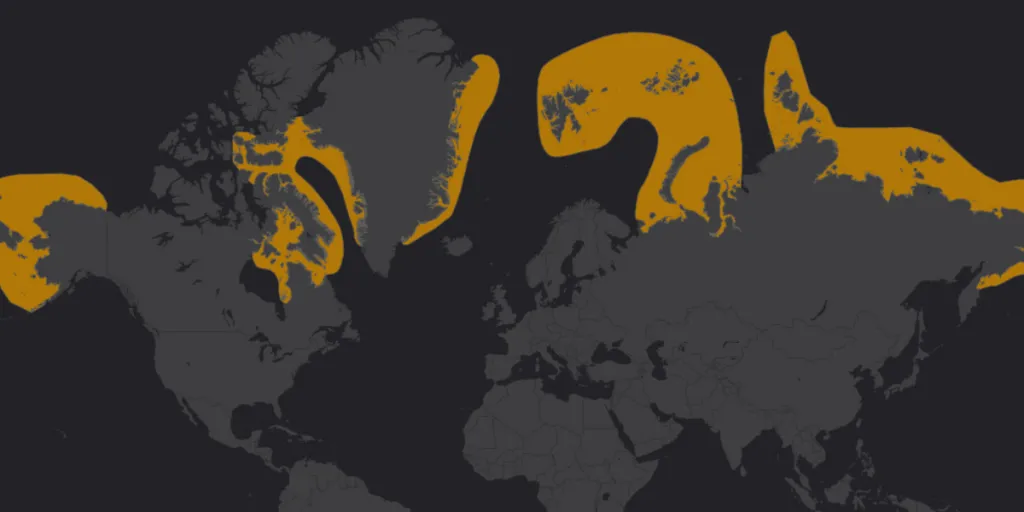Walruses are iconic marine mammals particularly due to their large size and impressive tusks. They live both inside and outside of the water, in very cold regions. However, they do not inhabit all the coldest areas and will have never seen a penguin. So where do walruses live?
Walruses live in the northern hemisphere. There are two subspecies of walrus, each with a different geographic distribution. Atlantic walruses live in the Atlantic Ocean from Canada to Greenland whereas Pacific walruses live in the Pacific Ocean above Russia and Alaska.
Keep reading to find out more about where walruses live, including why they spend up to a third of their time on land and where they originally came from. Alternatively, our interesting facts about walruses are a great place to learn more.
- Where Do Walruses Live?
- How and Why Do Walruses Live in the Arctic?
- Does A Walrus Live on Land or in Water?
- Where Do Walruses Come From?
- How Far Can a Walrus Travel?
- What Is the Habitat of a Walrus?
- Related Questions
- Do Walruses Live at the North pole?
- Do Walruses Live in Alaska?
- Do Walruses Live in Canada?
- Can A Walrus Live in Freshwater?
- What Do Walruses Go Under the Ice?
- Where Do Walruses Live in The United States?
- Are There Walruses in Antarctica?
- Are There Walruses in the UK?
- Are There Walruses in Australia?
- Do Walruses Live in the Same Place as Penguins?
Where Do Walruses Live?
Walruses live in the northern hemisphere. This map from IUCN shows where they can be found:

There are two main subspecies of walrus, the Atlantic and Pacific Walrus which are named based on their geographic distribution:
- Atlantic walruses (Odobenus rosmarus rosmarus) can be found in the Atlantic Ocean, inhabiting coastal areas from Canada to Greenland. These are the slightly smaller species.
- Pacific walruses (Odobenus rosmarus divergens) can be found in the Pacific Ocean, in the northern seas above Russia and Alaska. This marks the southernmost part of its range; southeast Unalaska Island1 (source: IUCN).
This detailed map gives a breakdown of the distribution between Atlantic (purple shading) and Pacific Walruses (yellow shading)2 (source: X. Keighley, et al, Quaternary Research, 2019).
There is also ongoing research into a potential third sub-species of walrus3 (source: BBC). Walruses found in the Laptev Sea around Russia are unique in some parameters though further investigation is required4 (source: C. Lindqvist, et al, Zoologica Scripta, Vol. 38, Issue 2, pp.113-127, 2009).
How and Why Do Walruses Live in the Arctic?
Walruses are specifically adapted to their habitat in the Arctic. To compensate for the cold environment, walruses have a thick layer of blubber which can be up to 4 inches5 (source: C.A. Repenning, Systematic Biology, Vol. 25, Issue 4, Pages 375–390, 1976).
Their large size is also a weapon against the cold, a walrus can be anywhere between 800kg and 1700kg. Larger animals have a lower surface area to weight ratio, this essentially means that they lose less body warmth to the cold relative to their overall size.
They are further adapted to stay warm by regulating their body temperature. They do this by restricting their blood away from the surface of their skin, towards their vital organs. This results in their appearance looking lighter than usual6 (source: Seaworld).
Does A Walrus Live on Land or in Water?
Walruses live both on land and in the water although they spend around two-thirds of their lives in the water7 (source: Seaworld). During this time, walruses mostly sleep, mate, travel, and forage for food8 (source: L. F. Lowry and F. H. Fay, Polar Biology, Vol. 3, pp.11–18, 1984).
Walruses are known to dive up over 100 meters deep however tend to inhabit shallower water. They dive in order to catch their main prey which are invertebrates found in and around the substrate (between 10-30 meters)9 (source: F.H. Fay and J.J. Burns,Arctic, Vol. 41 No. 3, pp.167–259, 1988). They use their whiskers as a sensory system to help detect and identify prey in the water. After each dive, a walrus will return to the surface to breathe for around one minute10 (source: Seaworld).
Walruses spend around one-third of their life out of the water on land. They move to land to rest and raise their young11 (source: Seaworld). Occasionally, walruses will leave the water to avoid conflict with predators such as orcas12 (source: WWF).
Walruses prefer to ‘haul out’ which is when they rest such as between foraging sessions. They are known to rest on moving pack-ice (ice formed by freezing of seawater), rather than actual landmass. They tend to spend the longest time hauling out when the most sea ice is available (i.e. winter), and less time hauling out when less ice is available (i.e. summer)13 (source: E. Guarde, et al, Journal of Experimental Marine Biology and Ecology, Vol. 500, pp.89-99, 2018).
In the summer months when there are fewer ice floes, walruses are more likely to rest on the landmass. This is particularly the case for Atlantic walrus as their feeding grounds are closer to land14 (source: WWF).
Where Do Walruses Come From?
Walrus fossils predate back 28,000 years, during the last ice age. Walruses have had longstanding importance in human culture. They have been hunted for subsistence by Inuit communities, alongside for commercial gain largely by Americans and Europeans15 (source: J.R. Bockstoce and D.B. Botkin, Arctic and Alpine Research, Vol. 14, No. 3, pp. 183-188, 1982).
Walruses are mammals. they are the only living member of the Odobenidae family which is part of the broader Pinniped family, including seals and sea lions.
Walruses evolved from their ancestors in the North Pacific before some dispersed into the North Atlantic via the Arctic Ocean. This is why we now have two main sub-species, Pacific and Atlantic waluses16 (source: R.W. Boessenecker and M. Churchill, The Atlantic Walrus, pp.9-37, 2021).
How Far Can a Walrus Travel?
Walruses are known to travel upwards of 3,000 km (1863 miles) every year17 (source: National Geographic). This is because walruses migrate seasonally. For example, the Pacific walrus migrates from the southern part of its range (the Bering Sea) to the northern part of its range (the Chukchi Sea). Here, the females give birth as they undertake the northern migration during the spring18 (source: E. Guarde, et al, Journal of Experimental Marine Biology and Ecology, Vol. 500, pp.89-99, 2018).
What Is the Habitat of a Walrus?
Walruses inhabit areas over the continental shelf areas, with direct access to drifting arctic pack-ice. This allows them to undertake regular dives for foraging, whilst being close to areas where they can rest by hauling out19 (source: E. Guarde, et al, Journal of Experimental Marine Biology and Ecology, Vol. 500, pp.89-99, 2018).
Related Questions
Do Walruses Live at the North pole?
Yes, walruses do live near the North Pole20 (source: IUCN). They have various adaptations which are necessary for them to survive in these conditions21 (source: C.A. Repenning, Systematic Biology, Vol. 25, Issue 4, Pages 375–390, 1976).
Do Walruses Live in Alaska?
Yes, walruses do live around Alaska. The Pacific walrus is found in this region including the Bering Sea and the Chukchi Sea22 (source: Alaska Department of Fish & Game).
Do Walruses Live in Canada?
Yes, walruses do live around Canada. More specifically, it is the Atlantic walrus that inhabits the northeastern Canadian Arctic areas. Many of the observations are made from the coastline in warm months. This is because the walruses move inland as the ice melts. This has led to herds of as many as 5,000 walruses being observed in this area23 (source: Canadian Geographic).
Can A Walrus Live in Freshwater?
Walruses are not found in freshwater. Walruses are found in saltwater marine environments.
What Do Walruses Go Under the Ice?
Walruses dive under the pack ice in order to forage for food. They can dive over 500 meters deep24 (source: E.Guarde, et al, Journal of Experimental Marine Biology and Ecology, Vol. 500, pp.89-99, 2018). However, walruses tend to hunt for food in shallow water between 10-50 meters (33-164 feet). This is because the organisms they prefer to eat are found in or around the substrate. During these dives, walruses can hold their breath for as long as 2530 minutes25 (source: Seaworld).
Where Do Walruses Live in The United States?
The Pacific walrus is found in Alaska. During the warm summer months, the walrus move away from the ice out at sea and move on land26 (source: Alaska Department of Fish & Game).
Are There Walruses in Antarctica?
No, walruses are not found in Antarctica. It is a common myth that walruses are found in Antarctica. Antarctica is in the southern hemisphere, and walrus are only found in the northern hemisphere27 (source: IUCN).
Are There Walruses in the UK?
Walruses are sighted occasionally around the United Kingdom and Ireland. For example, a walrus named “Wally” was reported to be off the coast of Cornwall in Autumn 202128 (source: Wales Online).
Are There Walruses in Australia?
No, walruses are not found in Australia. Australia is in the southern hemisphere, and walrus are distributed within the northern hemisphere29 (source: IUCN).
Do Walruses Live in the Same Place as Penguins?
No, walruses and penguins do not live in the same location; their distribution range do not overlap. Walruses live in the northern hemisphere and penguins live in the southern hemisphere.



![You are currently viewing Where Do Walruses Live? [With Map]](https://polarguidebook.com/wp-content/uploads/2022/06/Where-do-walrus-live.jpg)
![Read more about the article 16 Tusk-Worthy Facts about Walruses [#7 Will Shock You]](https://polarguidebook.com/wp-content/uploads/2022/09/Walrus-300x200.jpg)
![Read more about the article How Big Are Walruses? [Size + Weight Compared to Humans]](https://polarguidebook.com/wp-content/uploads/2022/09/Walrus-Size-300x200.jpg)
